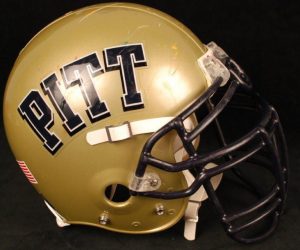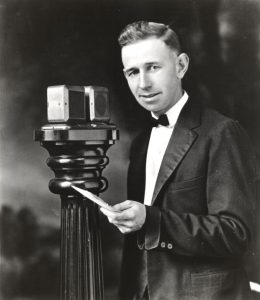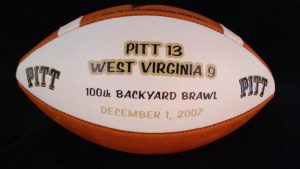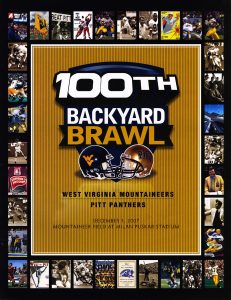Separated by just 70 miles, feelings run strong in the football rivalry between the University of Pittsburgh and West Virginia University. Sept. 1, 2022 marks the first time in more than a decade that the two teams will clash in what fans affectionately refer to as the “Backyard Brawl.”
Both teams sport blue and gold as their school colors, that, and an abiding dislike for the other may be all they share. The schools’ fledgling programs, Pitt’s (then Western University) football program began in 1889 and WVU’s in 1891, first played in 1895. West Virginia won that contest, 8-0, and took the next two games, in 1898 and 1900, as well. But in the 104 total meetings between the two, Pitt has the lead in wins with a record of 61-40-3.

Part of a collection of items collected to document the 100th Backyard Brawl. Gift of University of Pittsburgh, Heinz History Center.
Evenly matched in the beginning years of the contest, the teams traded wins. The first major run for either came in the period 1910 through 1921, when Pitt won all six games played. By 1915, legendary coach Glenn “Pop” Warner commanded the Panthers. In addition to these Brawl victories, he led Pitt to three national championships in 1915, 1916, and 1918. The 1921 game is also distinguished by being the first college football game broadcast over radio. Noted sports announcer Harold W. Arlin provided the play-by-play commentary from Forbes Field for KDKA radio.

On October 8, 1921 Harold Arlin covered the 21-13 win of Pitt over WVU on KDKA radio.
The following year, West Virginia ended Pitt’s streak, with a close win of 9-6, and then added another WVU victory the following year. The advent of Jock Sutherland’s coaching career at Pitt in 1924 turned the tide to the Panthers again. They won four straight with increasing margins of victory – the score in 1927 was 40-0 in favor of Pitt. West Virginia won in 1928 but was not victorious again until 1946. Pittsburgh won all 15 games in that period, taking a commanding lead in the series 30-8-1. During that same period, Pitt claimed another national championship in 1937.

Football commemorating the 100th Backyard Brawl played by the University of Pittsburgh and the West Virginia on December 1, 2007. Gift of the University of Pittsburgh, Heinz History Center.
The teams traded wins in the 1950s and 60s, with their highest scoring match–up coming on Oct. 2, 1965. The game that day went to West Virginia 63-48. The 1970 game featured one of the bigger upsets of the series, Pitt rallied from a 35-8 halftime deficit to defeat the Mountaineers by one point 36-35. West Virginia coach Bobby Bowden declared it one of his “darkest days in coaching.” John Majors’s national championship team in 1976 initiated another run of wins for the Panthers. The 199 rushing yards and three touchdowns notched by eventual Heisman trophy winner Tony Dorsett powered the Pitt team to a win in ‘76. The team then took seven straight games, the biggest margin of victory being Pitt’s 52-7 trouncing of the Mountaineers in 1978. West Virginia’s biggest streak, a run of five wins, began in 1992 when they beat Pitt on the Panthers home field 44-6. Pitt turned that trend around in dramatic fashion in 1997 – winning 41-38 in triple overtime earning a Liberty Bowl invite. Payback came in 2003, when West Virginia ran up 52 points over the No. 16 ranked Pitt team to win 52-31.

Program from the 100th Backyard Brawl on Dec. 1, 2007. Detre Library & Archives at the Heinz History Center.
In 2007 the two teams met for the 100th time. Undefeated West Virginia entered the game as 28-point favorites, ranked second in the nation. The Panthers shocked their rivals, holding the Top Ten offense of WVU to only nine points and pulling off a narrow-upset win 13-9. The Mountaineers turned the tables in 2009, beating the #8 ranked Panthers 19-16. They added another big win in 2010. The teams’ final meeting came in 2011, ending 68 years of consecutive play. That day belonged to WVU, with a one-point victory over Pittsburgh 21-20.
This season, the two teams begin a four-year series that will run through 2025, with four more meetings scheduled from 2029 through 2032. The rivalry, the 14th oldest in the country, has provided more than a century of excitement. As history has shown, anything can happen when these two battle for backyard bragging rights.